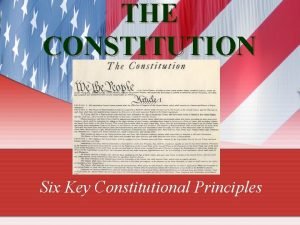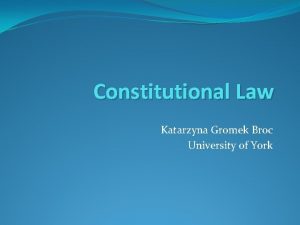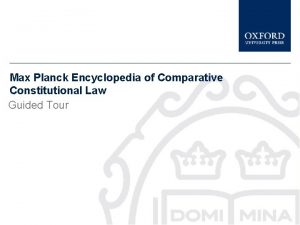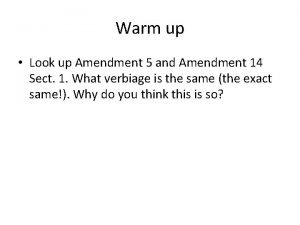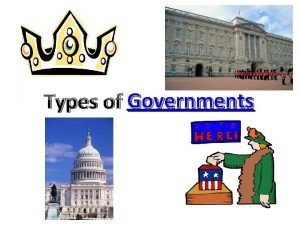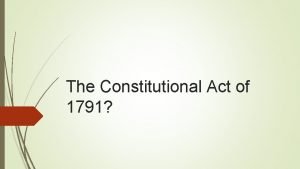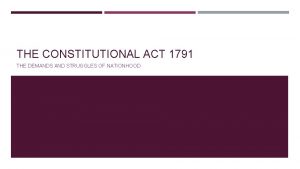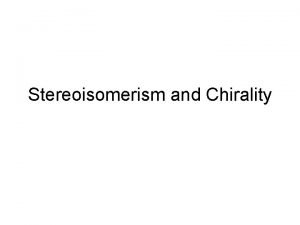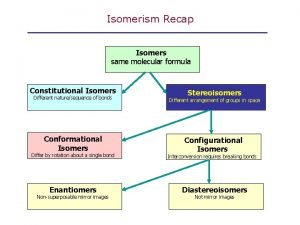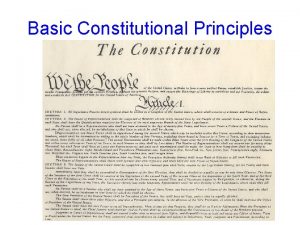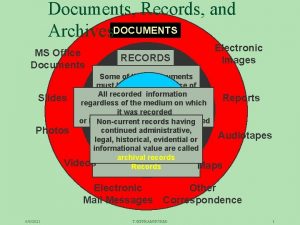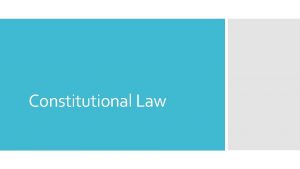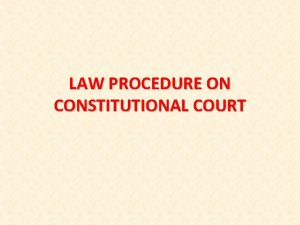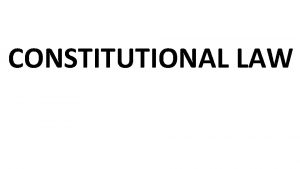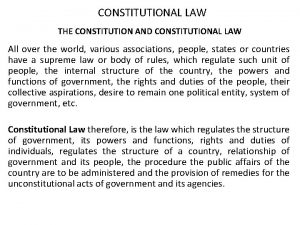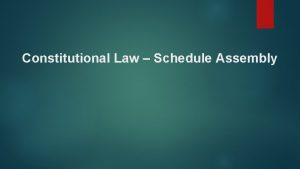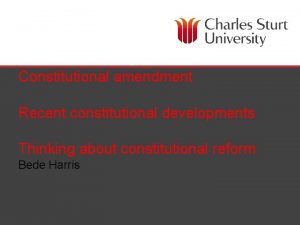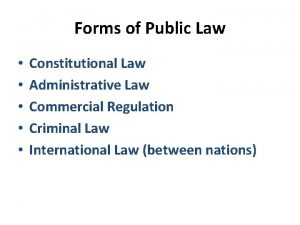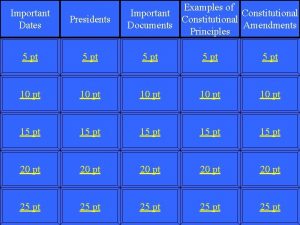Constitutional Documents Constitutional law the principles of the














- Slides: 14

Constitutional Documents Constitutional law = the principles of the constitution, the powers that are assigned by it (and how those powers are implemented through a country’s legal and political institutions), and the roles of the people who operate within those institutions Tuesday, December 12 Corresponds with pages 136 -140 of your textbook Constitutional documents are the most concrete source of Canada’s Constitution

The British North America Act ● 1867 ● At that time Canada was comprised of present-day Ontario, Quebec, New Brunswick, and Nova Scotia ● This act was the main document in Canada’s Constitution (became known as the Constitution Act, 1867) ● Stated that Canada would be modelled after Great Britain (parliamentary-style democracy) ● Also, the division of powers between the federal and provincial governments was outlined

The British North America Act ● Two omissions: ○ ○ Roles of prime minister and the Cabinet not made explicit (to be addressed by conventions) No formula for amending Canada’s Constitution (with the result that every time Canadians needed to make a change to their constitution, the federal government had to ask British Parliament to pass a bill) ● British Parliament passed a number of bills to amend the BNA Act ○ ○ when new provinces entered Confederation when new powers were assigned federal or provincial jurisdiction

The British North America Act ● In 1982, Canada "patriated" its Constitution, transferring the patriate (v): bring under the authority of the country to which the laws apply country's highest law, the British North America Act, from the authority of the British Parliament to Canada's federal and provincial legislatures. ● The Constitution was also updated with a new amending formula and a Charter of Rights —changes that occurred after a heated year and a half long political and legal struggle that dominated headlines and the agendas of every government in the country. ● The Queen signed the act into law on April 17, 1982

The Constitution Act, 1982 ● The Constitution Act is comprised of seven parts: ○ ○ ○ ○ Canadian Charter of Rights and Freedoms Rights of the Aboriginal Peoples of Canada Equalization and Regional Disparities Constitutional Conferences Procedure for Amending Constitution of Canada Amendment to The Constitution Act, 1867 General Note: This website is excellent because it breaks each part into smaller sections for more exploration - https: //yourlaws. ca/constitution-act-1982/264

The Constitution Act, 1982 federalist: : one who favours a strong centralized national government veto power: the official privilege, given to a specific person or people, to overrule a recommendation if desired ● ¨Constitution was patriated (brought home by Prime Minister ● ● ● To entrench (v): to codify rights so that they can be changed only by constitutional amendment, safeguarding them from political interference Trudeau, a federalist) ¨Included an amending formula reached by all provinces except Quebec (they wanted veto power) ¨Amending formula; any change to the Constitution must be agreed on by 2/3 of the provinces comprising 50% of the population ¨Incorporated the Charter of Rights and Freedoms, entrenching the rights of Canadians

The Royal Proclamation, 1763 ● ¨Established common law of England in all British territories in ● ● ● Interesting related case that the text alludes to (R. ● ● v. Sparrow): https: //scccsc. lexum. com/scc-csc/scc -csc/en/item/609/index. do North America ¨Described the relationship between Aboriginal peoples and the crown as a nation to nation ¨Prevented anyone from negotiating land deals with Aboriginal peoples without the authority of the Crown ¨Granted Aboriginal peoples title to use and occupy the land ¨The Crown owned all land that was not held privately ¨This proclamation is still referenced to uphold the rights of Aboriginal peoples.

The Quebec Act of 1774 ● ¨Act that guaranteed free practice of the Catholic faith. ● ¨It restored the use of the French civil law for private matters while maintaining the use of the English common law for public administration, including criminal prosecution. The impact of the distinct civil law in Quebec is that three out of the nine Supreme Court Justices in Canada are appointed from Quebec because of their expertise with the Civil Code of Quebec ●

The Constitution Act, 1791 ● ● ● Informative pronunication article: https: //www. thestar. com/ne ws/canada/2014/07/06/ho w_do_you_pronounce_lieu tenant_governor. html ● ● ¨ ¨Divided British North America into Upper and Lower Canada ¨Upper Canada (Ontario) received English law and institutions ¨Lower Canada (Quebec) retained French civil law and institutions, including seigneurial (semi-feudal) land tenancy, and the privileges accorded to the Roman Catholic Church. ¨Established a government structure comprised of a Lieutenant -Governor, executive and Legislative assembly ¨Executive was responsible to the Lieutenant-Governor and not the elected Legislative assembly

The Constitution Act, 1791 (graphic) ¨

Act of Union, 1840 ● ● ● parliamentary democracy: a system of government in which citizens elect representatives to a legislative parliament to make the necessary laws and decisions for the country. This parliament directly represents the people. ¨ Established responsible government with the executive now responsible to the elected Legislative Assembly This act unified Upper and Lower Canada ¨Lieutenant-Governor was now required to implement the will of the Legislative Assembly ¨Established a British parliamentary style of democracy ¨the distinct legal systems of the two colonies were retained

Statute of Westminster, 1931 ● ● ¨ Ended Canada’s colonial status Canadian government could now change laws previously passed as acts of British parliament that applied to Canada Granted independence for Canada, responsibility foreign affairs Canada could still not amend the British North America Act (federal and provincial governments could not agree on amending formula)

Discussion Questions What are possible consequences of having a constitution that is unclear? Could there be possible benefits to an unclear constitution?

Activity Turn to page 514 of the textbook ● Review the Canadian Charter of Rights and Freedoms ○ Part I of the Constitution Act, 1982 ● What evidence is there that this document is rooted in the past? ● How would you rank the Fundamental Freedoms? What is your rationale?
 Six constitutional principles
Six constitutional principles Scope of constitutional law
Scope of constitutional law Max planck encyclopedia of comparative constitutional law
Max planck encyclopedia of comparative constitutional law Newton's first law and second law and third law
Newton's first law and second law and third law Si unit of newton's first law
Si unit of newton's first law V=k/p
V=k/p P=k/v
P=k/v Gitlow v new york constitutional question
Gitlow v new york constitutional question Constitutional monarchy pros and cons
Constitutional monarchy pros and cons Constitutional act of 1791
Constitutional act of 1791 Constitutional act of 1791
Constitutional act of 1791 Meso compound
Meso compound Right to constitutional remedies
Right to constitutional remedies 2-methylpentane structural isomerism
2-methylpentane structural isomerism Stereoisomer vs constitutional isomer
Stereoisomer vs constitutional isomer
